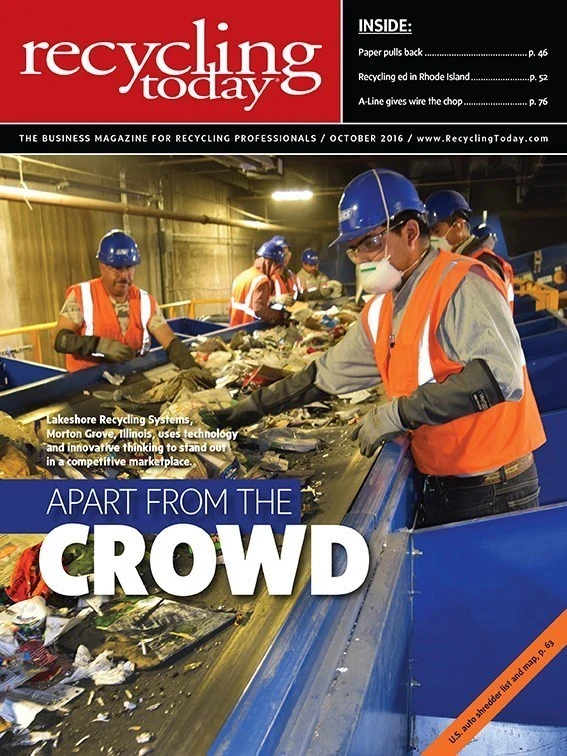September buying patterns by domestic mills did not point to a bright autumn 2016 ferrous scrap market, though export prices managed to stay steady. Of longer-term concern to buyers and sellers of ferrous scrap might be tapering vehicle sales figures for August.
As measured by the American Metal Market (AMM) Midwest Index pricing for early September 2016, domestic mills paid some $25 to $40 less per ton for ferrous scrap, depending on the grade and the mill location.

Recyclers say the lower pricing was tied to reduced demand from domestic mills rather than to an uptick in supply. A recycler in the Midwest says scrap flows have been unsteady throughout 2016. “It gets busy on market upticks, then it’s slow for a while, so there is no consistency”
Early September flows were “not too bad,” he adds, interpreting it as a signal that peddlers and smaller dealers who price watch may have been leery that prices would increase anytime soon.
Greg Dixon, a broker who is the CEO of Kentucky-based Smart Recycling Management (SRM), says, “Ferrous scrap flows into yards have been very slow” this summer.
He adds, “All obsolete items are in short supply, and that will make for an interesting dynamic heading into fall and winter.”
Despite tepid scrap flows, he was experiencing the price drops that contributed to AMM’s reduced September averages. “September pricing will be weaker, which will decrease that flow further. Many shredders [already] are running reduced hours and continue to look for new ways to utilize their equipment.”
The newly narrow price difference between obsolete and prompt scrap has been noticeable in his regional market, but the road to a wider spread may come in the form of bad news on the manufacturing side.
For much of 2016, Dixon says, “The only bright spot has been busheling, as car sales have remained high.”
However, figures collected from automotive dealers for August 2016 are casting doubts about the momentum in that sector.

“I think for the first time [in a while], we have seen a little slowdown in manufacturing,” Dixon says. “I’m not sure if it was just the late summer doldrums or an actual prolonged slowdown. It will be interesting to see what happens the balance of the year from that sector.”
Figures compiled by Autodata Corp., Mahwah, New Jersey, show an overall 4.1 percent drop in passenger car and light truck deliveries in August 2016 compared with August 2015.
Ford Motor Co.’s deliveries were down by 8.8 percent, while GM’s sales figure dropped 5.2 percent and Chrysler’s by 2.4 percent. The North American operations of Japanese companies fared little better, with Nissan falling 6.5 percent, Toyota off 5 percent and Honda down 3.8 percent.
Having been the scrap generating and metals consuming sector showing the greatest strength for a couple of years, an automotive sector hitting the brakes would be unwelcome news on all fronts for the scrap industry.
The ferrous scrap export market, which has been shrinking for several years in a row, will not be helped if a report out of Saudi Arabia regarding that kingdom’s fiscal straits proves accurate.
Bloomberg and other news agencies reported in early September that the Saudi government was scrutinizing its budget with an eye toward cancelling some $20 billion in infrastructure and building projects in the rest of 2016 and into 2017.
Such widespread cuts would have a ripple effect on metals supply, demand and pricing not only in Saudi Arabia’s Gulf Cooperation Council (GCC) region but also in Turkey, the single largest buyer of American exported ferrous scrap.
With the automotive sector potentially shifting to a slower gear, a rebound in domestic steel output seems unlikely in the U.S. Late summer statistics gathered by the Washington-based American Iron and Steel Institute (AISI) do not bode well for steelmakers or ferrous scrap recyclers.
“All obsolete items are in short supply, and that will make for an interesting dynamic heading into fall and winter.” – Greg Dixon, Smart Recycling Management
In the week ending Sept. 3, 2016, domestic steel output was 1.65 million tons, down 3.1 percent from the 1.71 million tons produced during the comparable week in 2015. The mill capacity rate fell to 70.8 percent compared with 71.5 percent in the comparable week in 2015.
Year-to-date domestic steel production stands at 60.9 million tons, with the year showing an average mill capacity rate of 72.4 percent. That is down 1.2 percent from the 61.7 million tons made during the same period last year, when the capacity rate was 72.3 percent.
Globally, production in the first seven months of 2016 is down by 1.2 percent, according to figures distributed by the Brussels-based World Steel Association (WorldSteel).
China has reduced output slightly (0.5 percent), while many of the nations that have filed steel trade complaints against it show greater decreases. The woes of the U.K. steel sector are most evident judged by its 36.4 percent decrease.
Get curated news on YOUR industry.
Enter your email to receive our newsletters.

Explore the October 2016 Issue
Check out more from this issue and find your next story to read.
Latest from Recycling Today
- ShearCore adds dealership group in Canada
- Hitachi forms new executive team for the Americas
- Southwire joins Vinyl Sustainability Council
- Panasonic, Sumitimo cooperate on battery materials recycling in Japan
- Open End Auto Tie Balers in stock, ready to ship
- Reconomy names new chief financial officer
- ICIS says rPET incentives remain weak
- New Jersey officials award $16.2M in annual recycling, waste reduction grants





